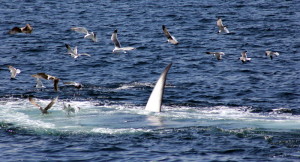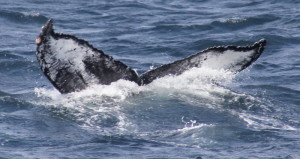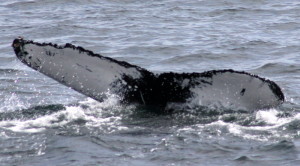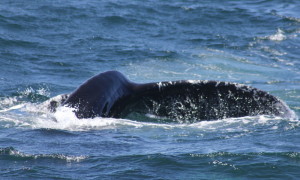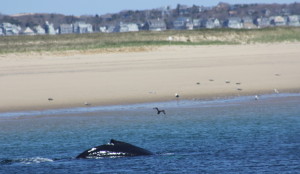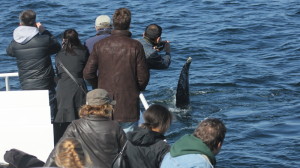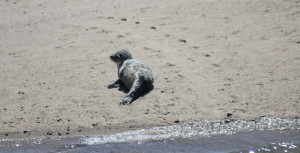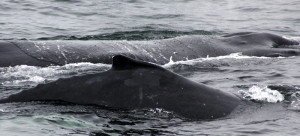Naturalist Notebook – April 26 to May 2
We left the dock on the morning of April 26th to find that there were a number of whales in and around Cape Cod Bay, all spending lots of time beneath the surface. Suddenly, as if a dinner bell had been rung, four species charged for a small area where they proceeded to feed heavily at the surface. Fin whales lunged and rolled slowly at the surface, exposing the not-often-seen ventral surface of their flukes.
At least 150, but possibly as many as 300 Atlantic white-sided dolphins darted and leaped through the schools of fish, while two Minkes were spotted charging through the bait. We were also able to identify at least 9 individual humpback whales, including Reflection, Xylem, Aerospace, and Compass’ 2008 calf.
Compass’ 2008 Calf
These whales were driving the fish to the surface by slapping their flukes on the water, stunning and confusing the small fish that were attracting all of these species to the area.
As quickly as it began, the feeding frenzy had come to a close by the time our afternoon went out. Though the animals had spread out, we were able to relocate Reflection and Aerospace, as well as our pod of dolphins!
Aerospace
By April 27th, the wind had picked up and it was very bumpy and windy, even in the protected waters of Cape Cod Bay. In the afternoon, we decided to brave it, as did one humpback whale who was bubble feeding at the surface despite the rough conditions. Although it was hard to get a positive ID on this whale while we were trying to keep our footing on the deck of the Dolphin VIII, we were later able to identify this whale as Blackboard, a humpback first seen in 2009.
We also had a very exciting interaction with a small group of Atlantic white-sided dolphins. We were only able to count about 16 individuals total — a small number compared to the huge numbers seen in previous days. Dolphin social groups are dynamic and sometimes will break up into smaller factions to forage and socialize.
The morning of April 28 we plowed through rough sees moving out to Wood End, only to watch the white caps subside to beautiful, flat, seas and sunny skies in the afternoon. In the afternoon, two miles north of Wood End, we found ourselves in the middle of four or five feeding humpbacks. the group included Reflection, Northstar, Aerospace and Jabiru.
Aerospace
Surrounding these humpbacks were over 100 Atlantic white-sided dolphins, a Minke, and even a fin whale — the second largest whale on the planet! John Conlon, one of the Dolphin Fleet’s veteran naturalists and crew members, has been working tireless updating a new fin whale catalog for the whale watch boats. At present, 119 fin whale individuals are in the catalog, identified mostly by the size and shape of their dorsal fin. The goal of such a progress is to be able to track individuals over time and to identify patterns and movements of the population as a whole.
April 29th was an unusual day both in the behavior and location of humpback whales. First, we were surprised to see a small unknown humpback right near the beach in Provincetown. There’s a steep drop-off from shore, so even though this whale was close to the beach, we were confident that it would travel offshore within the day. While strandings of small toothed whales are common on Cape Cod beaches, large baleen whales like humpbacks rarely strand.
Later, the Dolphin VIII experienced a prolonged close boat approach by two adult humpbacks. In general, it is young humpbacks or calves who express curiosity towards whale watch boats, but in this case, it was a humpback named Scarp. Scarp’s age is unknown, but from its size, we can surmise that this is a mature animal.
As we were pulling into the harbor, some sharp-eyed whale watchers spotted a seal pup hauled out Long Point. Seal pupping occurs in the spring and early summer, so this little seal is very young and small, and was probably waiting for it’s mother to come back from a foraging trip. In fact, if you look closely at the photo below, you can see its mothers tracks in the sand!
The highlight of April 30th‘s trip aboard the Dolphin VIII was a close approach from Scylla’s 2008 calf. We were initially alerted to this young humpback’s presence from a distance when we noticed the tell-tale splashes of a lobtailer. As we approached, we watched Scylla’s 2008 calf repeatedly slap its tail on the water, creating quite a ruckus! As soon as we stopped, it quickly became interested in the boat and spent nearly a half hour going back and forth beneath the boat, slapping its tail as it spun around, and blowing bubbles as it went beneath the boat.
On the way back to shore, we stopped to watch two humpback mother and calf pairs surrounded by a group of between 40 and 80 Atlantic white-sided dolphins. Although they are only a few months old, these young humpback whales dwarfed the 8-foot long dolphins that swam among them. Abrasion and Rapier are one of fifteen humpback whale females to return to the feeding grounds with calf in tow so far this year. Last year, 30 mother/calf humpback whale pairs were documented in the Gulf of Maine. Its still early in the season, and we expect to see our list keep growing!
May 2nd‘s trip began with some major excitement as we came upon a small pod of Common dolphins right in Cape Cod Bay. While we’ve been seeing Atlantic white-sided dolphins on a pretty regular basis over the past few weeks, Common dolphins are (ironically, considering their name) a bit more rare. While they can easily be confused with their similar-looking cousins, they can be identified by their characteristic hourglass shaped coloration pattern along their side.
Looking closely at the photo above, you can distinguish a small tag on the dorsal fin of the dolphin all the way to the right. This means that this was one of the hundreds of dolphins that stranded, and was successfully rescued and re-released. There is always some concern that dolphins re-released after a stranding even will either re-strand or won’t be able to re-locate their conspecifics, so it was reassuring to see this dolphin socializing and looking healthy after its traumatic past!
After spending some time with the dolphins, we traveled to Stellwagen Bank, a national marine sanctuary just north of Cape Cod Bay, where numerous humpbacks were moving about. We were especially excited to see Salt, our most famous, and one of the most frequent visitors to the Stellwagen Bank feeding grounds. We’ve been watching Salt since 1975 and she has returned every year.
The trip finished with a quick look at Thumper and her calf. The curious calf took a brief interest in the bow of the boat before rejoining its mother.
Thumper and calf






